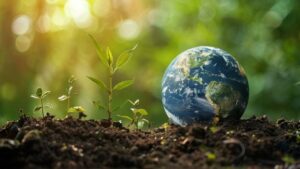Introduction to the Urgent Findings
The recent research unveiled by leading scientists presents a troubling perspective on the future of both our planet and its inhabitants. The findings underscore a critical and alarming trend: opportunities for sustainable prosperity are diminishing at an unprecedented rate. With each passing year, the cumulative impacts of climate change, resource depletion, and socioeconomic disparities are becoming more apparent, compelling experts to warn that we are at a pivotal crossroads in the pursuit of prosperity.
This research indicates that the window of opportunity to address these pressing challenges is rapidly closing. The interdependencies between environmental health and human well-being are clearer than ever. For instance, the degradation of natural ecosystems directly impacts food security and access to clean water, thus threatening the foundation of social stability and economic growth. If left unaddressed, these issues could exacerbate existing inequalities and hinder progress across generations.
Understanding the Study and Its Implications
The recent study published on ScienceDaily presents a comprehensive analysis of the current environmental challenges facing our planet. Its primary objective is to elucidate the interconnections between ecological degradation and human well-being. Researchers sought to highlight the dire consequences of unsustainable practices, which have led to a decline in biodiversity and an increase in climate-related disasters. The aim is not only to raise awareness but also to catalyze actionable strategies for mitigation and adaptation.
In conducting this research, a mixed-methods approach was employed. Quantitative data were collected through surveys and environmental assessments, while qualitative insights were gained through interviews with experts in ecology, sociology, and public health. This multifaceted methodology allowed the researchers to capture a holistic view of the planet’s health and its implications for human well-being. They analyzed key indicators such as air and water quality, biodiversity loss, and the socio-economic impacts of environmental degradation on vulnerable communities.
The critical conclusions drawn from the research are alarming yet insightful. The study reveals that the deterioration of the planet’s ecosystems poses a significant risk to human health, food security, and overall quality of life. Notably, it emphasizes that human activities such as deforestation, pollution, and unsustainable agriculture are at the forefront of this crisis. Furthermore, the researchers advocate for an immediate shift towards sustainable practices to reverse these trends. Their findings underscore the urgency of addressing environmental issues, as the health of our planet is inextricably linked to the prosperity of its inhabitants. The implications of this research extend beyond academia, urging policymakers and global citizens alike to take responsibility for safeguarding our shared future.
The Link Between Environmental Degradation and Economic Decline

The relationship between environmental degradation and economic decline is increasingly evident in numerous studies conducted across the globe. Researchers have established that poor environmental management not only threatens ecosystems but also severely impacts economies. One significant statistic indicates that for every 1% decrease in ecosystem services, there is a corresponding 1.5% decline in economic output. This is particularly concerning when one considers how vital clean air, fresh water, and fertile land are to sustainable development and economic health.
One compelling example comes from the Amazon rainforest, often referred to as the “lungs of the planet.” Deforestation in this region has not only led to biodiversity loss but has also disrupted local economies that depend on forest resources. Following the reduction in forest cover, many communities have experienced a decrease in agricultural productivity, resulting in both food insecurity and economic instability. The findings from this research indicate that neglecting environmental preservation can create a vicious cycle where economic challenges discourage sustainable practices, further exacerbating environmental degradation.
Additionally, the costs associated with natural disasters, which are often intensified by climate change, exemplify the strong linkage between the health of the environment and economic viability. Reports suggest that in 2020, climate-related disasters resulted in losses exceeding $300 billion in the United States alone. These figures highlight how the detriment to natural resources can lead to fallout on various economic sectors, including agriculture, tourism, and real estate. Acknowledging these statistics is essential for policymakers and business leaders to understand that investment in environmental conservation is not merely an ethical choice but a crucial economic strategy.
As the discourse continues to evolve, it becomes paramount for individuals and organizations alike to recognize that the path to continued economic prosperity is intertwined with sustainable environmental practices.
The Ripple Effect on Human Populations
The adverse consequences of environmental degradation are intricately linked to the human experience, affecting various populations globally. As the planet’s resources dwindle and ecosystems strengthen their decline, the repercussions are significant on socioeconomic structures. The correlation between the worsening environmental conditions and the rising instances of poverty is particularly alarming, as communities reliant on natural resources face the brunt of these changes. This scenario is evident in regions where agriculture is a primary source of livelihood; erratic weather patterns and diminishing arable land often lead to food insecurity, forcing families into a cycle of poverty.
Furthermore, environmental deterioration leads to a significant degree of migration. As natural disasters become more frequent and severe, vast populations are uprooted, seeking safer habitats. This migration, while often necessary for survival, can strain resources in host communities, creating tensions and conflicts over access to essential services such as housing, healthcare, and employment. Many regions already grappling with poverty may find their infrastructures ill-equipped to handle this influx, exacerbating existing challenges.
Health issues also arise as a direct result of deteriorating environmental conditions. Air and water pollution contribute to widespread health problems, disproportionately affecting vulnerable populations. Groups in low-income areas often experience higher exposure to toxins without adequate healthcare access, resulting in compounded health inequalities. As we increasingly observe these ramifications, it is crucial to understand how the degradation of our planet feeds back into human challenges that perpetuate cycles of suffering and hardship. These socioeconomic impacts underscore the urgency for action, wherein safeguarding the environment becomes paramount to the well-being of diverse populations worldwide.
Scientific Warnings and Global Responses

Recent scientific research has issued alarming warnings regarding the trajectory of global prosperity and the planet’s ecological health. Prominent studies indicate that rising temperatures, extreme weather occurrences, and habitat loss directly threaten biodiversity and human livelihoods. Researchers have underscored the urgency of addressing climate change, highlighting its potential to exacerbate socio-economic disparities and create widespread instability. Many scientists argue that if current trends continue, the repercussions may lead to food and water shortages, displacing millions of people and creating unmanageable refugee crises.
In response to these warnings, a variety of global initiatives have emerged aimed at fostering sustainability and countering the detrimental effects of climate degradation. Governmental bodies across the world have begun implementing policies to transition towards renewable energy, enhance public transportation, and promote sustainable agricultural practices. For example, countries like Germany and Denmark have ramped up investments in wind and solar power, acknowledging that a decisive shift is essential for long-term planetary health.
Nonprofit organizations have also stepped in to bolster these efforts by advocating for environmental conservation and the adoption of sustainable practices in industries such as agriculture, manufacturing, and transportation. Initiatives led by groups such as the World Wildlife Fund (WWF) and Greenpeace strive to educate the public about ecological risks and promote active engagement in environmental stewardship. Furthermore, private sector involvement has grown, with numerous corporations committing to carbon neutrality and investing in green technologies to lead the way in responsible business practices.
The collaboration between governments, nonprofits, and the private sector showcases a multifaceted approach to combating the challenges highlighted by scientists. While significant progress has been made, experts stress that concerted, collective efforts are critical to create a sustainable future for both our planet and its inhabitants.
Innovative Solutions and Sustainable Practices
As the challenges facing our planet become increasingly apparent, researchers and industry leaders are advocating for innovative solutions and sustainable practices that aim to address these pressing issues. Predominantly, this includes a blend of technological innovations, policy reforms, and community engagement initiatives that collectively work to foster environmental stewardship and economic prosperity.
One significant area of focus is the integration of renewable energy technologies. Advancements in solar, wind, and hydroelectric power not only reduce reliance on fossil fuels but also decrease greenhouse gas emissions significantly. Governments are encouraged to implement supportive policies that facilitate the adoption of these technologies, such as tax incentives for businesses and homeowners who invest in renewable energy solutions. Furthermore, energy efficiency standards for buildings and appliances can lead to significant reductions in energy consumption and subsequent carbon footprints.
In addition to energy innovation, sustainable agricultural practices are gaining traction as vital components of a prosperous future. Techniques such as crop rotation, organic farming, and integrated pest management promote biodiversity, improve soil health, and reduce chemical inputs. These sustainable practices not only enhance food security but also bolster the economic resilience of farming communities. Organizations are promoting educational initiatives to help farmers transition to these methods, ensuring long-term viability and ecological balance.
Moreover, community initiatives play an essential role in driving environmental and economic change. Local governments and non-profit organizations are developing programs aimed at reducing waste and promoting recycling. Educational campaigns that raise awareness about sustainability encourage citizens to adopt eco-friendly habits, fostering a culture of conservation and responsibility. By empowering communities to take action, these initiatives create a foundation for grassroots innovation, ensuring that efforts to promote prosperity are inclusive and impactful.
In conclusion, the intersection of technology, policy, and community initiatives presents a promising path toward sustainability. Through innovative solutions and sustainable practices, it is possible to mitigate the threats facing our planet while fostering economic growth and resilience for future generations.
Call to Action for Individuals and Communities
As the ongoing research highlights the alarming trajectory of environmental decline and its repercussions for both our planet and future generations, it becomes increasingly essential for individuals and communities to play an active role in promoting sustainability. Each person possesses the power to contribute positively to the environmental narrative through everyday choices and collective actions. By understanding the significance of these choices, we can foster a culture of sustainability that resonates beyond individual efforts.
One practical step is adopting energy-efficient practices at home. Utilizing LED light bulbs, reducing water wastage, and implementing smart thermostats can significantly lower one’s carbon footprint. Beyond individual households, community workshops can be organized to educate members about energy conservation and the importance of sustainable living.
Moreover, individuals are urged to embrace a more plant-based diet. By reducing meat consumption and opting for locally sourced produce, community members can support ethical farming practices and minimize excessive carbon emissions associated with industrial agriculture. Initiatives like community gardens can serve as a platform for individuals to collaborate, learn from each other, and promote healthier eating habits.
Engaging in local environmental clean-up efforts is another effective means of invigorating community spirit while directly addressing pollution issues. Participating in such activities not only improves local environments but also raises awareness about the impact of waste on ecosystems. In addition, advocating for policies that support renewable energy initiatives can amplify the collective voice of communities and demand systemic change from decision-makers.
In conclusion, the collaboration of individuals and communities is vital in reversing the detrimental trends outlined in research on environmental decline. Collectively embracing sustainable practices can ignite a powerful movement toward prosperity for our planet and its inhabitants.
Future Projections: What Lies Ahead?
As scientific studies continue to unveil the complexities of climate change and environmental degradation, future projections reflect a range of potential scenarios for our planet. The studies indicate that our trajectory significantly depends on immediate actions taken today. The worst-case scenario foresees a dramatic increase in global temperatures, nearing or surpassing 2 degrees Celsius above pre-industrial levels. This scenario would likely result in catastrophic events, including more frequent and severe weather patterns, rising sea levels, and loss of biodiversity. Such changes threaten the intricate balance of ecosystems and the livelihoods of millions, with vulnerable populations facing the direst consequences.
Conversely, best-case projections present a more optimistic outlook. If nations can unite to implement aggressive carbon reduction strategies and sustainable practices, we could stabilize global temperatures. Transitioning to renewable energy sources, enhancing energy efficiency, and protecting natural habitats play pivotal roles in this scenario. By prioritizing investment in green technologies and fostering innovation in sustainable agriculture, we may mitigate some adverse effects of climate change while promoting economic resilience. These measures would not only safeguard biodiversity but also ensure that future generations inherit a healthier planet.
Moreover, adaptive strategies to cope with the changes already underway are essential to minimize societal disruptions. Communities worldwide must enhance their resilience by improving infrastructure and disaster preparedness. Failing to act swiftly and decisively may usher in a future marked by escalating conflicts over dwindling resources and mass displacement due to environmental disasters, which could destabilize regions and economies alike.
In summary, the need for immediate action is clear; the future of our planet is at a critical juncture, and the choices we make today will significantly impact both our environment and our inhabitants for decades to come.
Conclusion: The Time for Change is Now
As we reflect on the concerning findings regarding the diminishing path to prosperity for our planet and its inhabitants, it becomes increasingly evident that urgent action is required. Scientists and environmental experts have long highlighted the pressing nature of climate change, resource depletion, and biodiversity loss. These challenges not only jeopardize our environment but also threaten the very fabric of our societies and economies. The time for change is indeed now, and collective responsibility is essential in addressing these critical issues.
Individuals, communities, corporations, and governments all play vital roles in combating the environmental crises we face. Each action counts, whether adopting sustainable practices in daily life, supporting policies that promote environmental stewardship, or advocating for changes within corporate landscapes to prioritize ecology over profit. It is imperative that we recognize the interconnectedness of our choices and the impact they have on the planet’s health and our future. The journey towards a sustainable existence demands commitment from all sectors of society, fostering a culture that values and prioritizes ecological balance.
In addition, investing in education and awareness is crucial to empower future generations. Knowledge about sustainable practices, conservation efforts, and the importance of biodiversity can help cultivate a deeper sense of responsibility toward the environment. By motivating individuals to adopt eco-friendly habits and urging policy changes that safeguard natural resources, we can work together to reverse the deficits afflicting our planet.
To secure a prosperous future for the Earth and all its inhabitants, we must act now. The responsibility is shared; the path to sustainability is achievable through collective will and action. Together, we can restore balance to our ecosystems and ensure a resilient and thriving future for generations to come.
